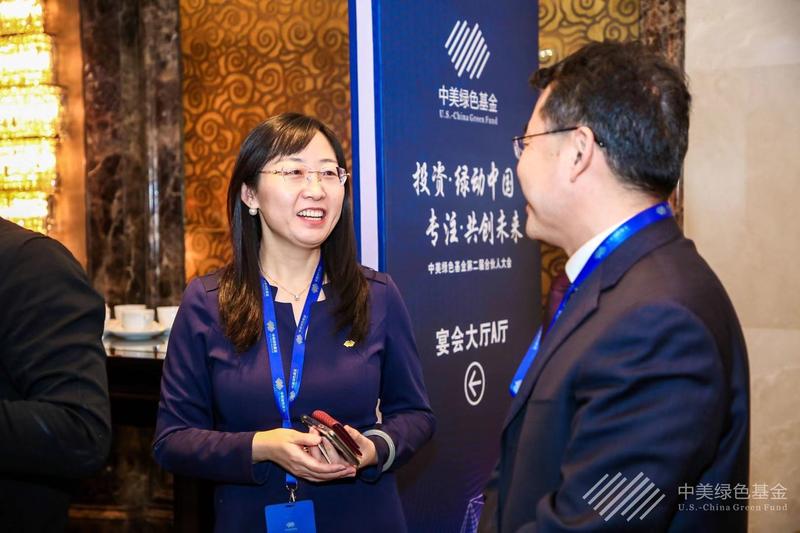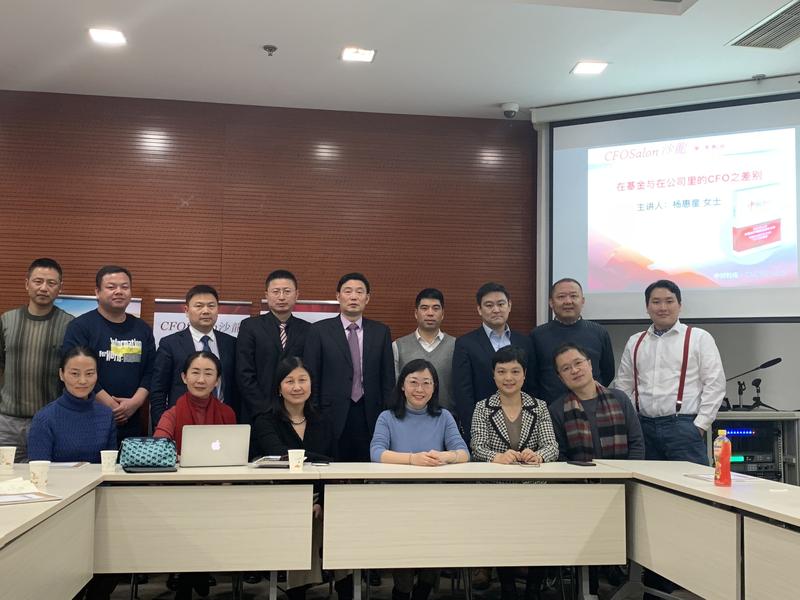 In this undated photo, Yang Huixing, executive director and head of finance of the China-US Green Fund, chats with a participant of the CFO salon session in Beijing. (PROVIDED TO CHINA DAILY)
In this undated photo, Yang Huixing, executive director and head of finance of the China-US Green Fund, chats with a participant of the CFO salon session in Beijing. (PROVIDED TO CHINA DAILY)
Yang Huixing’s initial understanding of equity funds was established in the audit work. It is through her work with some major firms that she developed a more profound understanding of financial issues, which helped her climb up the ladder of success.
Her highly coveted credentials brought Yang, executive director and head of finance of the China-US Green Fund, a prestigious invitation to share her insights at the second session of the second season CFO salon at the Peking University School of Economics on Jan 2.
Passionate about communication and sharing, she took to the podium, sharing first the differences between the fund CFO and the company's CFO, starting with her own experience.
The financial management of PE funds should take into account due diligence and post-investment management, said Yang Huixing, executive director and head of finance of the China-US Green Fund. There is an agent relationship between PE’s investment committee and project management team, she said
As the concept of fair value was being introduced in accounting standards, Yang was recruited in 2008, for a private equity audit team due to her experience in relevant projects. Three years later, she joined CITIC Industrial Fund where her main job was to build up a financial management system.
READ MORE: From banker to CFO of a listed company
For her, the CITIC fund was an excellent platform to reach different
For her, the CITIC fund was an excellent platform to reach different industries, including medical, energy and environmental protection, consumption and finance industries. Through in-depth internal audits, Yang had developed a more profound understanding of financial issues in the industries. She also participated in wealth management of family businesses and the construction and investment of FOF (fund of funds).
Joining Sequoia Capital later, Yang began setting up a horizontal comparison mechanism for multiple funds, measuring different investment funds in terms of industry distribution, performance, exit convenience and individual investor preferences.
During the post-investment work, she met various kinds of institutions, experiencing a variety of cases, such as foreign exchange management. She considers these experiences as opportunities to deeply understand different service providers and target companies.
For a fund CFO, one of the biggest work feature, apart from varying business patterns, is that the business content is comprehensive.
The finance management of PE funds needs to have a solid fundamental financial knowledge and the ability to leverage all service providers and reach out to companies in different industries and stages, said Yang.
First of all, a PE fund’s CFO has to design the rules of benefit distribution.
In the early stages of private equities, China's equity investors (limited partners, or LP) didn’t fully understand and agree with foreign PE rules. Besides a new set of rules that would balance the between the funds and LPs, they required to bring shareholders good investment returns and provide the management team attractive incentives.
As the trustee of the asset, how to share the interests with LPs is mainly defined through the limited partnership agreement. CFOs played an important role there. During the due diligence process, investors want to see the fund's historical performance. The finance team also needs to provide an effective comparative dimension to convince investors, Yang explained. The ultimate goal of all arrangements is to reach a win-win situation for LPs and funds.
 In this undated photo, Yang Huixing (third right, front row) and other guests attend the CFO Salon session in Beijing. (PROVIDED TO CHINA DAILIY)
In this undated photo, Yang Huixing (third right, front row) and other guests attend the CFO Salon session in Beijing. (PROVIDED TO CHINA DAILIY)
A CFO needs to communicate with the shareholders, who are most concerned about return on investment, the most difficult of which is earnings forecast. PE funds' earning forecast involves investment strategy, post-investment valuation, investment and exit decision-making, fund profit distribution, investment team performance appraisal etc. The finance team has to lock every number in the chain to provide an accurate projected result to shareholders, said Yang.
She also pointed out that performance appraisal and incentive distribution timing of the management team are pivotal and difficult in equity funds, in relation to retaining and motivating talents. The investment team’s payment is the largest expense for a PE, including their salaries and carry interest.
The financial management of PE funds should take into account due diligence and post-investment management, said Yang. There is an agent relationship between PE’s investment committee and project management team, she said.
ALSO READ: Business leaders give valuable insight
Stressing the importance of financial data for investment decision-making, she said on-site due diligence is usually done by a third party, while the project team builds a financial investment model based on the collected financial data. The fund’s financial team shall review the financial data to make sure whether due diligence scope is reasonable, work is complete and results are accurate.
The financial model requires assumptions such as growth assumptions, gross margin assumptions, and subsequent financing plan assumptions, Yang pointed out, adding that the finance department also needs to review the reasonability of assumptions.
In addition, the fund needs to combine strategic analysis and industry allocation while making investment decisions. To help the investment committee make right decisions, the finance team has to provide analysis from a macro perspective.
Talking on post-investment management, she said it includes not only continuous performance tracking, but also establishing financial norms and improvement of financial management capabilities. Besides introduction of various resources to help enterprises, the finance team also has to pay attention to the company’s cash flow and inventory life cycle to keep the fund responsive to possible financial risks in time, or choose to exit, she said.
The financial management of PE funds also needs to keep pace with the times to achieve digital management, Yang said.
Each limited partnership agreement, each fund and each investment unit may have different rules, and even a particular investor may have parallel supplementary agreements, which challenge standardized financial management in PEs, she pointed out. Combined with the time dimension, the general life of a fund is 10 years and the digital system would be enormous.
In recent years, many PE funds have started to set up financial systems to incorporate more financial information into the system.
Yang and her team have completed a fund financial management system, which can implant the fund’s limited partnership agreement terms and all financial data in the funds’ entire life cycle into the system to achieve one-click benefit distribution and real-time communication, just like a bank account. Thus, investors are able to see how much money there is in the account and how every penny is spent. This system greatly meets a range of requirements, such as internal management of fund, external supervision and investor performance due diligence reporting.


